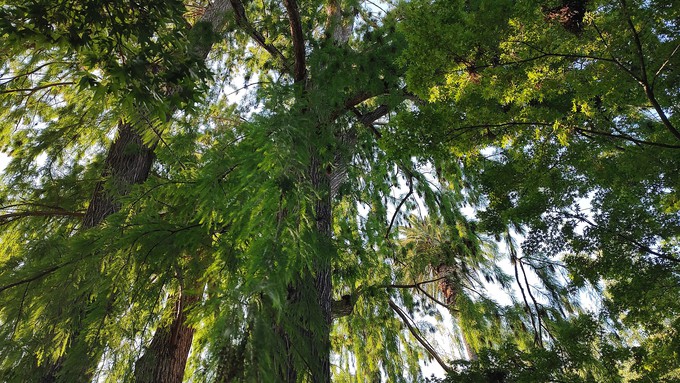
Program offers more choices to grow our urban forest

Redwood trees provide shade at Capital Park in Sacramento. You can add more shade to your own landscape with the Sacramento Shade program. Debbie Arrington
Sacramento loves its trees. During our recent heat wave, we’re especially thankful for their shade.
Here’s an opportunity to add to your own shade with free trees: Sacramento Shade.
Sacramento Shade is a partnership between the Sacramento Tree Foundation and SMUD, our local municipal utility. The program offers free trees to all SMUD customers. The extra shade can lower electricity consumption (and power bills) during intense summer heat. Urban trees also clean air and help cool neighborhoods.
Sacramento Shade can help SMUD customers add (or replace) valuable trees, says Alex Binck, community arborist for the Sacramento Tree Foundation.
Our intense winter storms took a dramatic toll on many trees particularly eucalyptus and elms, Binck notes. This year is a good time to put the right tree in the right place.
Binck has a special relationship with hundreds of Sacramento-area trees; he played a direct role in their planting. As a community forester, he helped residents pick out and site trees as part of the Sacramento Shade program.
SacTree experts such as Binck are currently studying which Sacramento trees did best (and worst) after our wet winter. They’re also trialing new tree varieties. Their observations will help shape recommendations for the Sacramento Shade program.
“With wild weather swings, we’re really trying to look at which trees are doing well and which are not,” Binck says. “It’s not only heat, but flood adapted, too. Even if it doesn’t ‘flood’ – flooding that impacts people – it can still be very, very wet soil.”
That wet aspect can be bad for trees native to dry habitats. Sacramento area trees have to withstand too much rain as well as too little.
“If you experiment with desert species, be careful,” he says. “Even if heat and drought adapted; wet soil can be challenging, especially wet clay soil. They just don’t like it.”
Desert Museum palo verde, for example, demands excellent drainage and sandy soil; that species does not like standing water.
Binck’s observations so far? Valley oaks are loving this year. “They tolerate both drought and wetter conditions. They can stand in four feet deep of water for weeks, then be bone dry in August. They’re big trees, though, and do need some space.”
California live oaks are doing well, too, as are olives. Binck recommends both of those trees; they’re well adapted to our climate but can take the weather swings, too. They also keep their foliage year round.
“Originally, we only had deciduous trees in the shade program and concentrated on energy savings,” Binck says, “but we now consider the holistic benefits of trees and added a few evergreens such as olive and live oak.”
Trees with intense fall color are popular in the Sacramento Shade program.
“Sacramento Shade’s most popular tree is the Shantung maple; people love its fall color,” Binck says. “It’s medium size, a little larger than a Japanese maple.”
Binck likes to recommend trees he knows will grow well here, not just now but for years to come.
“The reasons I like them: They’re adapted to our climate,” he says.
Binck’s short list of favorites: Zelkova (Zelkova serrata), a tough urban shade tree with great fall color; fern pine (Afrocarpus falcatus), a graceful African evergreen ornamental tree that’s neither fern nor pine; and desert willow (Chilopsis linearis), a small tree native to Southern California with beautiful trumpet-shaped blooms.
About two dozen varieties of trees are currently available via the Sacramento Shade program.
“When you meet with a community forester, you come up with a plan together and decide where each tree should go and the appropriate type for each area,” Binck.
For more on Sacramento Shade and great tree tips: https://sactree.org/.
Comments
0 comments have been posted.Sacramento Digs Gardening to your inbox.
Food in My Back Yard Series
April 1: Don't be fooled by these garden myths
March 25: Fertilizer tips: How to 'feed' your vegetables for healthy growth
March 18: Time to give vegetable seedlings some more space
March 11: Ways to win the fight against weeds
March 4: Potatoes from the garden
Feb. 25: Plant a fruit tree now -- for later
Feb. 18: How to squeeze more food into less space
Feb. 11: When to plant? Consider staggering your transplants
Feb. 4: Starting in seed starting
Sites We Like
Garden Checklist for week of March 30
Your garden doesn’t mind April showers. Get busy now to enjoy those future flowers.
* Get ready to swing into action in the vegetable garden. As nights warm up over 50 degrees, start setting out tomato, pepper and eggplant transplants.
* From seed, plant beans, beets, cantaloupes, carrots, corn, cucumbers, melons, pumpkins, radishes and squash. (Soak beet seeds overnight in water for better germination,)
* Plant onion sets.
* In the flower garden, plant seeds for asters, cosmos, celosia, marigolds, salvia, sunflowers and zinnias.
* Transplant petunias, zinnias, geraniums and other summer bloomers.
* Plant perennials and dahlia tubers for summer bloom.
* Transplant lettuce and cabbage seedlings.
* April is the last chance to plant citrus trees such as dwarf orange, lemon and kumquat. These trees also look good in landscaping and provide fresh fruit in winter.
* Smell orange blossoms? Feed citrus trees with a low dose of balanced fertilizer (such as 10-10-10) during bloom to help set fruit. Keep an eye out for ants.
* Apply slow-release fertilizer to the lawn.